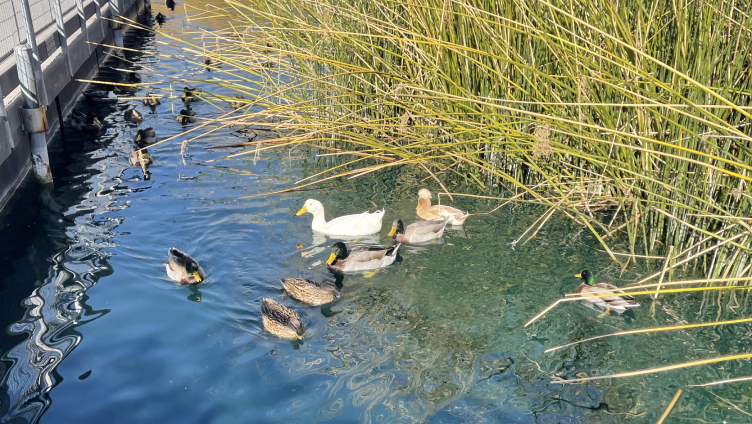advertisement
14 April 2022
If you’re around Gilbert and need a fun way to spend an afternoon (especially if you have kids), spending some time at the Riparian preserve is the way! And if you’re a resident, you may as well apply for a library card at the Southeast Regional Library and check out a new book!
advertisement

Parking is typically not an issue if you park at the library. There is a parking lot for the reserve itself, but it’s usually packed. The Southeast Regional Library has a big parking lot with a few trees to help shade your car in case it’s a hot day. Next, head down to the Riparian Preserve — it’s reasonably easy to understand where to go. If you’re into fishing, there are designated areas to fish. Also, check out this post about Arizona’s best places to fish.
advertisement
One of the first stops we usually take is to feed the ducks by the bridge. This is the only place authorized to provide the wildlife, so please don’t feed the wildlife once you venture deeper into the preserve. Also, remember to use food that is good for the ducks and not empty calories like bread. We always come with frozen peas to most ducks’ delight (some stick their nose up at it, but that’s their loss).
If you’re lucky, you can also spot the resident turtles. During one trip, we spotted six! They tend to sun themselves on the rock that protrudes up by the bridge.

After making some ducks happy, it’s fun to stroll through the paths of the preserve. If you’re a bird watcher, this place is heaven. So many different species of birds are attracted to the lush oasis in the Arizona desert. There are quite a few different routes woven throughout the preserve, so don’t be afraid to explore and take some new turns.
If you have kids, there’s a fun and unique playground and a place to set up for a BBQ. Birthdays, Weddings, and settings for professional photography, such as senior pictures, happen frequently, so if you’re looking for a good location, this is the place to be!

Arizona has so many diverse and exciting places to get out and play. The Riparian Preserve is undoubtedly one of our favorites!
advertisement
Arizona is a hiker’s paradise, whether you’re a seasoned adventurer or a casual weekend explorer, the state has a trail for every style, season, and skill level. Here are some of the best places to hike in Arizona. advertisement 1. Cathedral Rock – Sedona Difficulty: Moderate to strenuous Why It’s Amazing: This iconic red-rock formation offers one of Sedona’s most breathtaking climbs. The trail is steep, hands-on, and rewarding with unforgettable panoramic views. 2. Camelback Mountain – Phoenix Difficulty: Strenuous Why It’s Amazing: One of the most famous urban hikes in the country, Camelback delivers challenging scrambles, busy energy, and
When most people picture Arizona, they imagine cactus-filled deserts and blazing summer heat. But head north or climb in elevation, and a completely different side of the state appears: powdery snow, pine forests, cozy cabins, and ski runs with sweeping mountain views. Arizona’s snowy adventures offer a surprising winter escape for travelers who want chill instead of sizzle. advertisement Where to Find Snow in Arizona Snow in Arizona is all about elevation. The higher the climb, the better the chance of a winter wonderland. Northern and eastern Arizona are the prime regions for cold-weather fun, with pine-covered plateaus and mountain
Arizona, with its impressive diversity, surprises newcomers and constantly defies stereotypes. While many people picture endless deserts, triple-digit temperatures, and sunburn as far as the eye can see, the reality is far more varied. Here are the top 10 misconceptions about Arizona, and the truth behind them. advertisement 1. Arizona Is Just a Hot, Dry Desert Most people imagine the entire state melting under 115°F heat. And while parts of Arizona (like Phoenix and Yuma) are famously sizzling, the state also has snow-covered mountains, forests, alpine lakes, and ski resorts. Flagstaff, for example, sits at around 7,000 feet in altitude
A towering wall of dust can roll across central Arizona on a monsoon evening, swallowing skylines, grounding flights, and cutting visibility to near zero across parts of the Phoenix metro. Spectacular? Absolutely. Routine? In the Southwest, yes. These dramatic dust storms—called haboobs—are a hallmark of Arizona’s summer monsoon. Here is what they are, how they form, and how to stay safe when one arrives. advertisement What Is a Haboob? A haboob is a fast-moving dust storm generated by thunderstorm outflow winds. As a storm cell collapses or surges forward, dense, cool air rushes toward the ground and spreads outward like
advertisement
| Cookie | Duration | Description |
|---|---|---|
| cookielawinfo-checkbox-analytics | 11 months | This cookie is set by GDPR Cookie Consent plugin. The cookie is used to store the user consent for the cookies in the category "Analytics". |
| cookielawinfo-checkbox-functional | 11 months | The cookie is set by GDPR cookie consent to record the user consent for the cookies in the category "Functional". |
| cookielawinfo-checkbox-necessary | 11 months | This cookie is set by GDPR Cookie Consent plugin. The cookies is used to store the user consent for the cookies in the category "Necessary". |
| cookielawinfo-checkbox-others | 11 months | This cookie is set by GDPR Cookie Consent plugin. The cookie is used to store the user consent for the cookies in the category "Other. |
| cookielawinfo-checkbox-performance | 11 months | This cookie is set by GDPR Cookie Consent plugin. The cookie is used to store the user consent for the cookies in the category "Performance". |
| viewed_cookie_policy | 11 months | The cookie is set by the GDPR Cookie Consent plugin and is used to store whether or not user has consented to the use of cookies. It does not store any personal data. |
